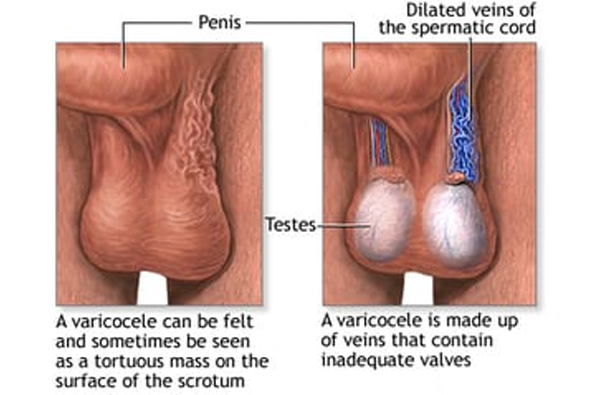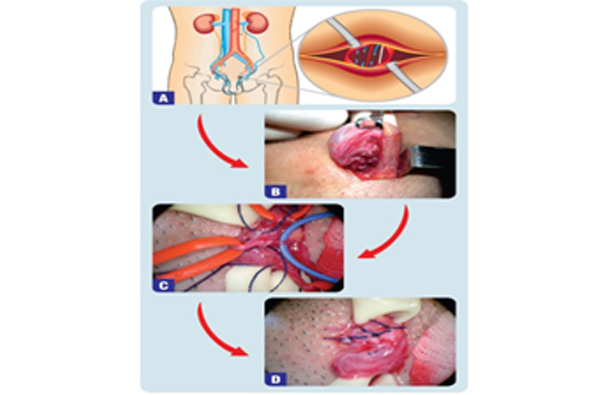Varicocele Treatment Services in Kukatpally, Hyderabad
A Varicocele treatment services is an enlargement of the veins within the loose bag of skin that holds your tes-ticles (scrotum). A varicocele is similar to a varicose vein you might see in your leg.
Varicoceles are a common cause of low sperm production and decreased sperm quality, which can cause infertility. However, not all varicoceles affect sperm production. Varico-celes can also cause testicles to fail to develop normally or shrink.
Varicoceles, enlarged scrotal veins, can be a source of male infertility, pain, and may even impair testosterone production. If your surgeon believes your are a candidate for microsur-gical varicocele repair
Symptoms of Varicocele
1. Pain
- Vary from sharp to dull discomfort in scrotum
- Increase with standing or physical exertion, especially over long periods
- Worsen over the course of a day
- Be relieved when you lie on your back
Causes
A varicocele forms when the valves inside the veins in the cord prevent your blood from flowing properly. The resulting backup causes the veins to widen (dilate). This might cause damage to the testicle and result in worsened fertility.
Complications
A varicocele might cause:
Shrinkage of the affected testicle (atrophy). The bulk of the testicle comprises sperm-producing tubules. When damaged, as from varicocele, the testicle shrinks and sof-tens.
The malfunctioning valves allow blood to pool in the veins, which can result in in-creased pressure in the veins and exposure to toxins in the blood that may cause testicular damage.
Infertility- Varicoceles might keep the local temperature in or around the testicle too high, affecting sperm formation, movement (motility) and function.
Treatment for Varicocele
If your varicocele causes pain, testicular atrophy or infertility or if you are considering as-sisted reproductive techniques, you might want to undergo varicocele repair.
The purpose of surgery is to seal off the affected vein to redirect the blood flow into normal veins. In cases of male infertility, treatment of a varicocele might improve or cure the infertil-ity or improve the quality of sperm if techniques such as in vitro fertilisation (IVF) are to be used.
Clear indications to repair a varicocele in adolescence include progressive testicular atro-phy, pain or abnormal semen analysis results. Although treatment of a varicocele generally improves sperm characteristics, it’s not clear if an untreated varicocele leads to progressive worsening of sperm quality over time.
1. Open Surgery
If your varicocele causes pain, testicular atrophy or infertility or if you are considering as-sisted reproductive techniques, you might want to undergo varicocele repair.
The purpose of surgery is to seal off the affected vein to redirect the blood flow into normal veins. In cases of male infertility, treatment of a varicocele might improve or cure the infertil-ity or improve the quality of sperm if techniques such as in vitro fertilisation (IVF) are to be used.
Clear indications to repair a varicocele in adolescence include progressive testicular atro-phy, pain or abnormal semen analysis results. Although Varicocele treatment services of a varicocele generally improves sperm characteristics, it’s not clear if an untreated varicocele leads to progressive worsening of sperm quality over time.
2. Microsurgical Varicocelectomy
Open surgery using a microscope and subinguinal ap-proach (microsurgical subinguinal varicocelectomy) has the highest success rates when compared with other surgical methods.
Technical aspects of microsurgical varicocelectomy
An operating microscope allows for ×6 to ×25 magnification of the operating field, consid-erably enhancing the surgeon’s visual acuity and ability for precision. Magnification allows for meticulous hemostasis, identification and preservation of testicular arteries and lym-phatics, and avoidance of inadvertent iatrogenic injuries.Microsurgical varicocelectomy can be performed using either an inguinal or subinguinal incision .Both approaches allow ele-vation of the spermatic cord for improved visualisation of the cord structures, provide ac-cess to external spermatic and gubernacular veins and allow delivery of the ipsilateral tes-ticle, for biopsy or examination under the microscope. Because the subinguinal incision obviates the need for opening any fascial layer, it is theoretically associated with a faster and less painful recovery.
Advantages of Microscopic Varicocelectomy
- We can avoid post op hydrocele
- Day care surgery
- High success rate
Percutaneous Embolisation
A radiologist inserts a tube into a vein in your groin or neck through which instruments can be passed. Viewing your enlarged veins on a monitor, the doctor releases coils or a solution that causes scarring to create a blockage in the testicular veins, which interrupts the blood flow and repairs the varicocele. This procedure isn’t as widely used as surgery.
Testimonials
FAQ's
Are varicoceles common?
Yes, varicocele is common. It can be found in 15 percent of the adult male population and 20 percent of adolescent males. They are common in males aged between 15 to 25.
How can varicocele be diagnosed?
A varicocele is diagnosed after a physical exam. If the results are inconclusive, your doctor may need to perform a scrotal ultrasound.
What are the risks associated with varicocele?
Varicocele does not cause any risks by themselves unless they interrupt with infertility or cause pain. The risks of a varicocele repair may include:
- The build-up of fluid around the testicles
- Recurrence of varicoceles
- Infection
- Damage to artery
Complications of varicoceles?
It can have an impact on the fertility of men. Varicoceles are known to cause primary infertility in 35 to 44 percent of men and secondary infertility in 45 to 81 percent on men. Talk to your doctor about seeing a reproductive specialist if you and your partner have trouble conceiving a child.





